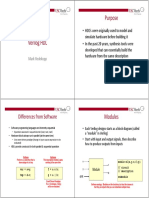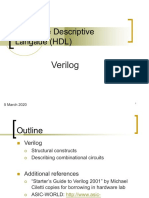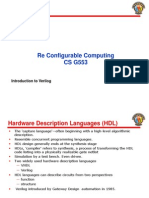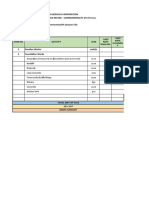Verilog HDL Introduction
ECE 554 Digital Engineering Laboratory
Charles R. Kime
1/26/2002 1
�Overview
Simulation and Synthesis Modules and Primitives Styles Structural Descriptions Language Conventions Data Types Delay Behavioral Constructs Compiler Directives Simulation and Testbenches
2
1/28/2001
�Simulation and Synthesis
Simulation tools typically accept full set of Verilog language constructs Some language constructs and their use in a Verilog description make simulation efficient and are ignored by synthesis tools Synthesis tools typically accept only a subset of the full Verilog language constructs
In this presentation, Verilog language constructs not supported in Synopsys FPGA Express are in red italics There are other restrictions not detailed here, see [2].
1/28/2001 3
�Modules
The Module Concept
Basic design unit Modules are:
Declared Instantiated
Modules declarations cannot be nested
1/28/2001
�Module Declaration (FIO*)
Syntax
module_declaration ::= module_keyword module_identifier [list of ports]; {module_item} endmodule module_keyword ::= module|macromodule list_of_ports ::= (port {, port}) * For Information Only not to be covered in presentation
1/28/2001 5
�Module Declaration (FIO)
module_item
Syntax (continued)
::= module_item_declaration | parameter_override | continuous_assign | gate_instantiation | udp_instantiation | module_instantiation | specify_block | initial_construct | always_construct
module_item_declaration ::= parameter_declaration | input_declaration | output_declaration | inout_declaration | net_declaration | reg_declaration | integer_declaration | real_declaration | time_declaration | realtime_declaration | event_declaration | task_declaration | function_declaration parameter_override ::= defparam list_of_parameter_assignments udp declaration
1/28/2001 6
�Module Declaration
Annotated Example
/* module_keyword module_identifier (list of ports) */ module C_2_4_decoder_with_enable (A, E_n, D) ; input [1:0] A ; // input_declaration input E_n ; // input_declaration output [3:0] D ; // output_declaration assign D = {4{~E_n}} & ((A == 2'b00) ? 4'b0001 : (A == 2'b01) ? 4'b0010 : (A == 2'b10) ? 4'b0100 : (A == 2'b11) ? 4'b1000 : 4'bxxxx) ; // continuous_assign endmodule
1/28/2001 7
�Module Declaration
Identifiers - must not be keywords! Ports
First example of signals Scalar: e. g., E_n Vector: e. g., A[1:0], A[0:1], D[3:0], and D[0:3] Range is MSB to LSB Can refer to partial ranges - D[2:1] Type: defined by keywords
input output inout (bi-directional)
1/28/2001
�Module Instantiation
Example
module C_4_16_decoder_with_enable (A, E_n, D) ;
input [3:0] A ; input E_n ; output [15:0] D ; wire [3:0] S; wire [3:0] S_n; C_2_4_decoder_with_enable DE (A[3:2], not N0 (S_n, S); C_2_4_decoder_with_enable D0 (A[1:0], C_2_4_decoder_with_enable D1 (A[1:0], C_2_4_decoder_with_enable D2 (A[1:0], C_2_4_decoder_with_enable D3 (A[1:0], endmodule
1/28/2001 9
E_n, S);
S_n[0], S_n[1], S_n[2], S_n[3],
D[3:0]); D[7:4]); D[11:8]); D[15:12]);
�Module Instantiation (FIO)
Syntax
module _instantiation ::= module_identifier [parameter_value_assignment] module_instance {, module_instance}; parameter_value_assignment ::= # (expression {, expression}) module_instance ::= name_of_instance ([list_of_module_connections]) name_of_instance ::= module_instance_identifier [range] list of module connections ::= ordered_port_connection {, ordered_port_connection} | named_port_connection {, named_port_connection} ordered_port_connection ::= [expression] named_port_connection ::= . port_identifier ([expression])
1/28/2001 10
�Module Instantiation
More Examples
Single module instantiation for five module instances
C_2_4_decoder_with_enable DE (A[3:2], D0 (A[1:0], D1 (A[1:0], D2 (A[1:0], D3 (A[1:0], E_n, S), S_n[0], D[3:0]), S_n[1], D[7:4]), S_n[2], D[11:8]), S_n[3], D[15:12]);
Named_port connection
C_2_4_decoder_with_enable DE (.E_n (E_n), .A (A[3:2]) .D (S)); // Note order in list no longer important (E_n and A interchanged).
1/28/2001 11
�Primitives
Gate Level
and, nand or, nor xor, xnor buf , not bufif0, bufif1, notif0, notif1 (three-state)
Switch Level
*mos where * is n, p, c, rn, rp, rc; pullup, pulldown; *tran+ where * is (null), r and + (null), if0, if1 with both * and + not (null)
1/28/2001 12
�Primitives
No declaration; can only be instantiated All output ports appear in list before any input ports Optional drive strength, delay, name of instance Example: and N25 (Z, A, B, C); //instance name Example: and #10 (Z, A, B, X); // delay (X, C, D, E); //delay /*Usually better to provide instance name for debugging.*/ Example: or N30 N41 (SET, Q1, AB, N5), (N25, ABC, R1);
1/28/2001
13
�Styles
Structural - instantiation of primitives and modules RTL/Dataflow - continuous assignments Behavioral - procedural assignments
1/28/2001
14
�Style Example - Structural
module full_add (A, B, CI, S, CO) ; input A, B, CI ; output S, CO ; module half_add (X, Y, S, C); input X, Y ; output S, C ;
wire N1, N2, N3;
half_add HA1 (A, B, N1, N2), HA2 (N1, CI, S, N3); or P1 (CO, N3, N2); endmodule
1/28/2001
xor (S, X, Y) ; and (C, X, Y) ;
endmodule
15
�Style Example - RTL/Dataflow
module fa_rtl (A, B, CI, S, CO) ;
input A, B, CI ; output S, CO ; assign S = A ^ B ^ CI; //continuous assignment assign CO = A & B | A & CI | B & CI; //continuous assignment
endmodule
1/28/2001
16
�Style Example - Behavioral
module fa_bhv (A, B, CI, S, CO) ; input A, B, CI ; output S, CO ;
reg S, CO;
// required to hold values between events.
always@(A or B or CI) //; begin S <= A ^ B ^ CI; // procedural assignment CO <= A & B | A & CI | B & CI; // procedural assignment end endmodule
1/28/2001 17
�Structural Descriptions
Textual description of schematic Form of netlist Connections Hierarchy Arrays of instances Hierarchy established by instantiation of modules and primitives within modules
18
1/28/2001
�Connections
By position association
module C_2_4_decoder_with_enable (A, E_n, D); C_4_16_decoder_with_enable DX (X[3:2], W_n, word); A = X[3:2], E_n = W_n, D = word
By name association
module C_2_4_decoder_with_enable (A, E_n, D); C_2_4_decoder_with_enable DX (.E_n(W_n), .A(X[3:2]), .D(word)); A = X[3:2], E_n = W_n, D = word
1/28/2001 19
�Connections
Empty Port Connections
module C_2_4_decoder_with_enable (A, E_n, D); C_2_4_decoder_with_enable DX (X[3:2], , word); E_n is at high-impedance state (z) C_2_4_decoder_with_enable DX (X[3:2], W_n ,); Outputs D[3:0] unused.
1/28/2001
20
�Arrays of Instances
{ , } is concatenate Example
module add_array (A, B, CIN, S, COUT) ; input [7:0] A, B ; input CIN ; output [7:0] S ; output COUT ;
wire [7:1] carry;
full_add FA[7:0] (A,B,{carry, CIN},S,{COUT, carry}); // full_add is a module
1/28/2001
endmodule
21
�Language Conventions
Case-sensitivity
Verilog is case-sensitive. Some simulators are case-insensitive Advice: - Dont use case-sensitive feature! Keywords are lower case
Different names must be used for different items within the same scope Identifier alphabet:
Upper and lower case alphabeticals decimal digits underscore
1/28/2001
22
�Language Conventions
Maximum of 1024 characters in identifier First character not a digit Statement terminated by ; Free format within statement except for within quotes Comments:
All characters after // in a line are treated as a comment Multi-line comments begin with /* and end with */
Compiler directives begin with // synopsys Built-in system tasks or functions begin with $ Strings enclosed in double quotes and must be on a single line
1/28/2001 23
�Logic Values
Verilog signal values
0 - Logical 0 or FALSE 1 - Logical 1 or TRUE x, X - Unknown logic value z, Z - High impedance condition
Also may have associated strength for switch level modeling of MOS devices
7 signal strengths plus 3 charge strengths
1/28/2001 24
�Number Representation
Format: <size><base_format><number>
<size> - decimal specification of number of bits
default is unsized and machine-dependent but at least 32 bits
<base format> - ' followed by arithmetic base of number
<d> <D> - decimal - default base if no <base_format> given <h> <H> - hexadecimal <o> <O> - octal <b> <B> - binary
<number> - value given in base of <base_format>
_ can be used for reading clarity If first character of sized, binary number is 0, 1, the value is 0filled up to size. If x or z,value is extended using x or z, respectively.
1/28/2001 25
�Number Representation
Examples:
6b010_111 8'b0110 8b1110 4'bx01 16'H3AB 24 5'O36 16'Hx 8'hz gives gives gives gives gives gives gives gives gives 010111 00000110 00001110 xx01 0000001110101011 00011000 11100 xxxxxxxxxxxxxxxx zzzzzzzz
26
1/28/2001
�Variables
Nets
Used for structural connectivity
Registers
Abstraction of storage (May or may not be real physical storage)
Properties of Both
Informally called signals May be either scalar or vector
1/28/2001 27
�Data Types - Nets Semantics
wire - connectivity only; no logical tri - same as wire, but will be 3-stated in hardware
wand - multiple drivers - wired and wor - multiple drivers - wired or
triand - same as wand, but 3-state trior - same as wor but 3-state supply 0 - Global net GND supply 1 - Global Net VCC (VDD) tri0, tri 1, trireg
28
1/28/2001
�Data Types - Nets - Syntax
Net declaration ::= net type [vectored | scalared] [range] [delay3] list_of_net_identifiers; | trireg [vectored | scalared] [charge strenth] [range] [delay3] list_of_net_identifiers; | net type [vectored | scalared] [drive strength] [range] [delay 3] list_of_net_decl_assignments;
Vectored - multiple-bit net treated as a single object cannot reference individual bits or part-select Scalared - bits can be referenced individually or be part selected
Value implicitly assigned by connection to primitive or module output
1/28/2001 29
�Net Examples - Single Driver
wire x; wire x, y; wire [15:0] data, address; wire vectored [0:7] control; data[15] (instantiation) address[15:8] (instantiation) wire address = offset + index;
30
1/28/2001
�Net Examples - Multiple Drivers and Constant Nets
wor interrupt_1, interrupt_2; tri [31:0] data_bus, operand_bus;
1/28/2001
31
�Initial Value & Undeclared Nets
Initial value of a net
At tsim = 0, initial value is x.
Undeclared Nets - Default type
Not explicitly declared default to wire default_nettype compiler directive can specify others except for supply0 and supply1
1/28/2001
32
�Data Types - Register Semantics
reg - stores a logic value integer stores values which are not to be stored in hardware
Defaults to simulation computer register length or 32 bits whichever is larger No ranges or arrays supported May yield excess hardware if value needs to be stored in hardware; in such a case, use sized reg.
time - stores time 64-bit unsigned real - stores values as real num realtime - stores time values as real numbers
1/28/2001 33
�Register Assignment
A register may be assigned value only within: a procedural statement a user-defined sequential primitive a task, or a function. A reg object may never by assigned value by: a primitive gate output or a continuous assignment
1/28/2001 34
�Register Examples
reg a, b, c; reg [15:0] counter, shift_reg; integer sum, difference;
1/28/2001
35
�Strings
No explicit data type Must be stored in reg (or array) reg [255:0] buffer; //stores 32 characters
1/28/2001
36
�Constants
Declaration of parameters
parameter A = 2b00, B = 2b01, C = 2b10; parameter regsize = 8;
reg [regsize - 1:0]; /* illustrates use of parameter regsize */
1/28/2001
37
�Operators
Arithmetic (binary: +, -,*,/,%*); (unary: +, -) Bitwise (~, &,|,^,~^,^~) Reduction (&,~&,|,~|,^,~^,^~) Logical (!,&&,||,==,!=,===,!==) Relational (<,<=,>,>=) Shift (>>,<<) Conditional ? : Concatenation and Replications {,} {int{ }}
38
* unsupported for variables
1/28/2001
�Expression Bit Widths
Depends on:
widths of operands and types of operators
Verilog fills in smaller-width operands by using zero extension. Final or intermediate result width may increase expression width
1/28/2001
39
�Expression Bit Widths
Unsized constant number- same as integer (usually 32) Sized constant number - as specified x op y where op is +, -, *, /, %, &, |, ^, ^~:
Arithmetic binary and bitwise Bit width = max (width(x), width(y))
1/28/2001 40
�Expression Bit Widths (continued)
op x where op is +, Arithmetic unary Bit width = width(x) Carry can be captured if final result width > width(x)
op x where op is ~
Bitwise negation Bit width = width(x)
1/28/2001 41
�Expression Bit Widths (continued)
x op y where op is ==, !==, ===, !===, &&, ||, >, >=, <, <= or op y where op is !, &, |, ^, ~&, ~|, ~^
Logical, relational and reduction Bit width = 1
x op y where op is <<, >>
Shift Bit width = width(x)
1/28/2001 42
�Expression Bit Widths (continued)
x?y:z
Conditional Bit width = max(width(y), width(z))
{x, , y}
Concatenation Bit width = width(x) + + width(y)
{x{y, , z}}
Replication Bit width = x * (width(y) + + width(z))
1/28/2001
43
�Expressions with Operands Containing x or z
Arithmetic
If any bit is x or z, result is all xs. Divide by 0 produces all xs.
Relational
If any bit is x or z, result is x.
Logical
== and != If any bit is x or z, result is x. === and !== All bits including x and z values must match for equality
1/28/2001 44
�Expressions with Operands Containing x or z
Bitwise
Defined by tables for 0, 1, x, z operands.
Reduction
Defined by tables as for bitwise operators.
Shifts
z changed to x. Vacated positions zero filled.
Conditional
If conditional expression is ambiguous (e.g., x or z), both expressions are evaluated and bitwise combined as follows: f(1,1) = 1, f(0,0) = 0, otherwise x.
1/28/2001
45
�Synthesis from Verilog
Note use of reg in behavioral descriptions; does not always imply actual storage such as latches or registers in synthesis results. Procedural statements are executed sequentially.
1/28/2001
46
�Delay Uses and Types
Ignored by FPGA Express; may be useful for simulation Uses
Behavioral (Pre-synthesis) Timing Simulation Testbenches Gate Level (Post-synthesis and Pre-Layout) Timing Simulation Post-Layout Timing Simulation
Types
Gate Delay (Inertial Delay) Net Delay (Transport Delay) Module Path Delay
1/28/2001
47
�Transport and Inertial Delay
Transport delay - pure time delay Inertial delay
Multiple events cannot occur on the output in a time less than the delay.
Example AND with delay = 2
A
B
1 ns
C
C
1/28/2001
Transport Delay Inertial Delay
48
�Gate Propagation Delay (Inertial) - Syntax (FIO)
delay3 ::= # delay_value | # (delay_value [, delay_value [,delay_value]]) delay2 ::= # delay_value | # (delay_value [,delay_value]) delay_value ::= unsigned number | parameter_identifier | constant_mintypmax_expression constant_mintypmax_expression ::= constant_expression | constant_expression : constant_expression : constant_expression
1/28/2001 49
�Gate Propagation Delay (Inertial) - Examples
No delay value - default - delays are all 0.
nor (z, x1 x2)
Delay_value - unsigned_number = 1 - unit delay
nor #1 (z, x1, x2);
Delay_value - unsigned_number 1 - prop delay
nor #5 (z, x1, x2);
Delay_value - parameter_identifier - allows easy
change of delay value
nor #nor_delay (z, x1,x2);
1/28/2001 50
�Gate Propagation Delay (Inertial) - Examples (FIO)
Delay_value2 - unsigned_number - rising delay,
falling delay
nor #(1,2) (z, x1, x2);
Delay_value3 - unsigned_number - rising delay,
falling delay, turnoff delay
nor #(3,2,4) (z, x1, x2);
Delay_value3 - constant_mintypmax_expression -
rising delay - min:typ:max, falling delay min:typ:max, turnoff delay - min:typ:max
nor #(2:3:4, 1:2:5, 2:4:6)
1/28/2001
51
�Simulation Time Scales
Compiler Directive `timescale <time_unit> / <time_precision> time_unit - the time multiplier for time values time_precision - minimum step size during simulation - determines rounding of numerical values Allowed unit/precision values: {1| 10 | 100, s | ms | us | ns | ps}
1/28/2001 52
�Simulation Time Scales (continued)
Example:
`timescale 10ps / 1ps nor #3.57 (z, x1, x2); nor delay used = 3.57 x 10 ps = 35.7 ps => 36 ps
Different timescales can be used for different sequences of modules The smallest time precision determines the precision of the simulation. Will ignore time issues for system tasks/functions
1/28/2001 53
�Net Delay (Transport)
Delay assigned to net such as wire Type of delay (inertial or transport) defined by object assigned to. Example - Structural:
`timescale 10ps /1ps wire #4 N25; nor #(20,30) GA (N25, x1, x2), GB (z, N25, X3); For rising output from x1 to z, 300 + 40 + 200 = 540 ps
1/28/2001 54
�Net Delay (Transport)
Example - Continuous Assignment
`timescale 10ps /1ps wire #4 N25;\\transport delay assign #(20,30) N25 = ~ (x1 | x2); \\inertial delay For rising output from x1 to N25, 200 + 40 = 240 ps
Example - Implicit Continuous Assignment
`timescale 10ps /1ps wire #(24,34) N25 = ~ (x1 | x2);\\inertial delay only For rising output from x1 to N25, 240 ps
1/28/2001
55
�Module Delay - Example
Add to module: specify (x1, x2 *> z) = (18:25:33, 24, 31, 40); endspecify Specifies minimum, typical, and maximum delays on paths from x1 to z and x2 to z.
1/28/2001
56
�Behavioral Constructs
Concurrent communicating behaviors => processes same as behaviors Two constructs
initial - one-time sequential activity flow - not synthesizable but good for testbenches Always - cyclic (repetitive) sequential activity flow
Use procedural statements that assign only register variables (with one exception)
1/28/2001
57
�Behavioral Constructs (continued)
Continuous assignments and primitives assign outputs whenever there are events on the inputs Behaviors assign values when an assignment statement in the activity flow executes. Input events on the RHS do not initiate activity control must be passed to the statement.
1/28/2001
58
�Behavioral Constructs (continued)
Body may consist of a single statement or a block statement A block statement begins with begin and ends with end Statements within a block statement execute sequentially Behaviors are an elaborate form of continuous assignments or primitives but operate on registers (with one exception) rather than nets
1/28/2001 59
�Behavioral Constructs Example
Initial:
initial begin one = 1; two = one + 1; three = two + 1; four = three + 1; five = four + 1; end
1/28/2001
Always:
always begin F1 = 0, F2 = 0; # 2 F1 = 1; # 4 F2 = 0; # 2 F1 = 1; # 4; end
60
What are results of each of above?
�Procedural Assignments
Types
= blocking assignment assign = continuous assignment <= non-blocking assignment
Assignments (with one exception) to:
reg integer real realtime time
61
1/28/2001
�Procedural Assignments Some Rules
Register variable can be referenced anywhere in module Register variable can be assigned only with procedural statement, task or function Register variable cannot be input or inout Net variable can be referenced anywhere in module Net variable may not be assigned within behavior, task or function. Exception: force release Net variable within a module must be driven by primitive, continuous assignment, force release or module port
1/28/2001 62
�Procedural Continuous Assignment (FIO)
Two types
assign deassign
to register variable dynamic binding to target register
force release
to register or net variable dynamic binding to target register or net variable
1/28/2001
63
�Procedural Continuous Assignment - Examples
Example 1:
// Q is a reg. What does this describe? always @ (clk)
if clk = 1 assign Q = D; else assign Q = Q;
1/28/2001
64
�Procedural Continuous Assignment - More (FIO)
A Procedural Continuous Assignment overrides all regular procedural assignments to variables Assignment Modes - See [5] Figure 7-8 p. 172
1/28/2001
65
�Procedural Timing, Controls & Synchronization
Mechanisms
Delay Control Operator (#) Event Control Operator (@)* Event or Named Events wait construct
*Ignored by FPGA express unless a synchronous trigger that infers a register
1/28/2001 66
�Procedural Timing, Controls & Synchronization
Delay Control Operator (#)
Precedes assignment statement - postpones execution of statement For blocking assignment (=), delays all statements that follow it Blocking assignment statement must execute before subsequent statements can execute. Example: always @(posedge clk),
#10 Q = D;
1/28/2001
67
�Procedural Timing, Controls & Synchronization
Event Control Operator (@)*
Synchronizes the activity flow of a behavior to an event (change) in a register or net variable or expression Example 1: @ (start) RegA = Data; Example 2: @(toggle) begin
@ (posedge clk) Q = D;
end
toggle above will be ignored unless in block
*Ignored by FPGA express unless a synchronous trigger 1/28/2001that infers a register 68
�Procedural Timing, Controls & Synchronization
Event or - allows formation of event expression Example: always @ (X1 or X2 or X3) assign Y = X1 & X2 | ~ X3; All RHS variables in sensitivity list and no unspecified conditional results => combinational logic
1/28/2001 69
�Procedural Timing, Controls & Synchronization
Meaning of posedge: 0 -> 1, 0 -> x, x -> 1 Special Example:
always @ (set or reset or posedge clk) begin if (reset == 1) Q = 0; else if (set == 1) Q = 1; else if (clk == 1) Q = data; end // Does this work correctly? Why or why not?
1/28/2001 70
�Procedural Timing, Controls & Synchronization (FIO)
Named Events
module cpu (); always @ (peripheral.interrupt) begin ... end module peripheral (); event interrupt; -> interrupt;
1/28/2001
71
�Procedural Timing, Controls & Synchronization (FIO)
wait Construct
Suspends activity in behavior until expression following wait is TRUE
Example:
always begin a = b; c = d; wait (advance);
end
1/28/2001 72
�Blocking Assignments
Identified by = Sequence of blocking assignments executes sequentially Example:
always @(posedge clk) begin b = 0; c = 0; b = a + a; c = b + a; d = c + a; end
1/28/2001 73
�Non-Blocking Assignments
Identified by <= Sequence of non-blocking assignments executes concurrently Example 1:
always @(posedge clk) begin
b <= 0; c <= 0; b <= a + a; c <= b + a; d <= c + a;
end /*Calculates b = 2a, c = b + a, d <= c + a. All values used on RHS are those at posedge clock. Note that there are two assignments to b and c. Only the last one is effective. */ 74
1/28/2001
�Blocking Assignments Inter-Assignment Delay
Delays evaluation of RHS and assignment to LHS
Example:
always @(posedge clk) begin b = 0; c = 0; b = a + a; // uses a at posedge clock #5 c = b + a; // uses a at posedge clock + 5 d = c + a; // uses a at posedge clock + 5 end /*c = 2 a(at posedge clock)+ a(at posedge clock + 5) d = 2 a(at posedge clock) + 2 a(at posedge clock + 5)*/
1/28/2001
75
�Blocking Assignment Intra-Assignment Delay
Delays assignment to LHS, not evaluation of RHS
Example:
always @(posedge clk) begin b = 0; c = 0; b = a + a; // uses a at posedge clock c = #5 b + a; // uses a at posedge clock d = c + a; // uses a at posedge clock + 5 end /* c = 3 a(at posedge clock) d = 3a (at posedge clock)+ a (at posedge clock + 5)*/
1/28/2001
76
�Non-Blocking Assignment Inter-Assignment Delay
Delays evaluation of RHS and assignment to LHS Delays subsequent statements
Example:
always @(posedge clk) begin b <= 0; c <= 0; b <= a + a; // uses a at posedge clock #5 c <= b + a; // uses b and a at posedge clock + 5 d <= c + a; // uses a at posedge clock + 5 end /*c = b(at posedge clock + 5) + a(at posedge clock + 5) d = c(at posedge clock + 5) + a (at posedge clock +5) */
1/28/2001 77
�Non-Blocking Assignment Intra-Assignment Delay
Delays only assignment to LHS
Example:
always @(posedge clk) begin b <= 0; c <= 0; b <= a + a; // uses a at posedge clock c <= #5 b + a; // uses a and b at posedge clock d <= c + a; // uses a and c at posedge clock end /* Calculates *c(posedge clock + 5) = b(at posedge clock) + a(at posedge clock); d(posedge clock) = c(at posedge clock) + a (at posedge clock) */
1/28/2001 78
�Mixed Blocking/NonBlocking Assignments
Example 1:
always @(posedge clk) begin b = 0; c = 0; d = 0; b = a + a; c <= b + a + d; d = c + a; end /*Calculates b = 2a, c = 2a, d = a since 1) RHS of c evaluates when statement reached, but LHS assigned to c last after all blocking assignments including that for d and 2) assignment of c does not delay execution of evaluation of d */
1/28/2001
79
�Mixed Blocking/Nonblocking Assignments
Example:
always @(posedge clk) begin d <= 0; b = a + a; c = b + a; d <= c + a; c = d + a; end /* Since the d <= c + a is non-blocking, c = d + a proceeds to execute before the assignment of d <= c + a. The resulting values calculated are b = 2a, d = 4a, and c = a + d (value of d is that at posedge clk, not that due to non-blocking assignment statement. */
80
1/28/2001
�Mixed Blocking/Nonblocking Assignment
For synthesis in ECE 554:
A given register can have either blocking or non-blocking assignments, not both. Delays cannot be used in always statements with mixed assignments It is advisable to avoid the confusion of the prior example to write code with all nonblocking assignments last among the code statements
1/28/2001 81
�Activity Control
Overview
Constructs for Activity Control
Conditional operator case statement if else statement Loops : repeat, for, while, forever disable statement fork join statement
Tasks and Functions
1/28/2001 82
�Conditional Operator
?: Same as for use in continuous assignment statement for net types except applied to register types Example:
always@(posedge clock)
Q <= S ? A : B //combined DFF and 2-to-1 MUX
1/28/2001
83
�Case Statement (FIO)
case Syntax:
case_statement ::= case (expression) case_item {case_item} endcase | casex (expression) case_item {case_item} endcase | casez (expression) case_item {case_item} endcase case_item ::= expression {,expression} : statement_or_null |default [:] statement_or_null statement_or_null ::= statement | ;
1/28/2001
84
�case Statement
Requires complete bitwise match over all four values so expression and case item expression must have same bit length Example: always@(state, x) begin
reg[1:0] state; case (state) 2b00: next_state <= s1; 2b01: next_state <= s2; 2b10: if x next_state <= s0; else next_state <= s1; end default next_state = 1bxx; endcase end
1/28/2001
85
�casex Statement
Requires bitwise match over all but positions containing x or z; executes first match encountered if multiple matches. Example:
always@(code) begin casex (code) 2b0x: control <= 8b00100110; //same for 2b0z 2b10: control <= 8b11000010; 2b11: control <= 8b00111101; default control <= 8bxxxxxxxx; endcase end
1/28/2001 86
�casez Statement
Requires bitwise match over all but positions containing z or ? (? is explicit dont care); executes first match encountered if multiple matches. Example:
reg [1:0] code; always@(code) begin casez (code) 2b0z: control <= 8b00100110; 2b1?: control <= 8b11000010; default control <= 8bxxxxxxxx; endcase end
1/28/2001 87
�Conditional (if else) Statement Example
always@(a or b or c) begin if (a == b) begin q <= data; stop <= 1b1; end else if (a > b) q <= a; else q <= b; end end 1/28/2001 end
88
�Conditional (if else) Statement (continued)
Must be careful to define outcome for all possible conditions failure do do so can cause unintentional inference of latches! else is paired with nearest if when ambiguous use begin and end in nesting to clarify. Nested if else will generate a serial or priority like circuit in synthesis which may have a very long delay - better to use case statements to get parallel circuit.
1/28/2001 89
�for Loop Example
Example: initial integer r, I; begin r = 0; for (i = 1; i <= 7; i = i + 2) begin r[i] = 1; end end If the loop above were in time rather than space, should use reg instead of integer!
1/28/2001 90
�while Loop Example
Not synthesizable since forms combinational loop! initial begin r = 0; i = 0; while (i <= 7) begin r[2*i + 1] = 1; i = i + 1; end end 1/28/2001
91
�forever Loop Example
initial begin clk = 0; forever begin
#50 clk = 1; #50 clk = 0; end
end Usually used in testbenches rather than for synthesized logic.
1/28/2001 92
�Tasks (FIO)
Declared within a module Referenced only by a behavior within the module Parameters passed to task as inputs and inouts and from task as outputs or inouts Local variables can be declared Recursion not supported although nesting permitted (nested copies of variables use same storage) See Fig. 7.43 p. 226 of [5]for rules
1/28/2001
93
�Tasks (FIO)
Syntax task_declaration ::= task task_identifier {task_item_declaration} statement or null endtask
1/28/2001
94
�Task Example
task leading_1; input [7:0] data_word; output [2:0] position; reg [7:0] temp; reg [2:0] position; begin temp = data_word; position = 3'b111; while (!temp[7]) @(posedge clock) //* begin temp = temp << 1; position = position - 1; end end endtask //* This may not work unclear contradictory statements in FPGA Express documentation.
1/28/2001
95
�Functions (FIO)
Implement combinational behavior No timing controls or tasks which implies no while May call other functions with no recursion Reference in an expression, e.g. RHS No output or inout allowed Implicit register having name and range of function
1/28/2001
96
�Functions (FIO)
Syntax:
function_declaration ::= function [range or type] function_identifier; function_call ::= function_identifier (expression {, expression}) Example:
position = leading_1(data_val);
1/28/2001 97
�Function Example
function [2:0] leading_1; input [7:0] data_word; reg [7:0] temp; begin temp = data_word; leading_1 = 3'b111; while (!temp[7]) begin temp = temp << 1; leading_1 = leading_1 - 1; end end endfunction Is the above code synthesizable? No
1/28/2001 98
�Finite State Machines Explicit and Implicit Models
Explicit - declares a state register that stores the FSM state Implicit - describes state implicitly by using multiple event controls Mealy versus Moore types
1/28/2001
99
�Types of Explicit Models
State register - Combinational next state and output logic State register - Combinational next state logic - Combinational output logic State register - Combinational next state logic - Registered output logic
1/28/2001
100
�State register - Combinational next state and output logic
Inputs Outputs
Next State and Output Logic
State Register
FF
1/28/2001
101
�State register - Combinational next state logic - Combinational output logic
Mealy Inputs Outputs
Next State Logic
State Register
Output Logic
FF
1/28/2001
102
�State register - Combinational next state and output logic - Output register
Output Register Inputs Outputs
Next State and Output Logic
State Register
FF
FF
1/28/2001
103
�State register - Combinational next state logic - Registered output logic
Mealy Inputs Output Register Outputs FF
Next State Logic
State Register
Output Logic
FF
1/28/2001
104
�FSM Example: Washer
start = 0 full = 0 timeout = 0
start_s
start = 1
fill_s
full = 1
water = 1 /timeset = 1 timeout = 0 reset = 1 timeout = 1 wring_s spin = 1 empty = 1
wash_s spin = 1
empty = 0 timeout = 1
drain_s
/timeset = 1 drain = 1
105
1/28/2001
�Verilog - state register - next state and output logic
module control_es1 (reset, clk, start, full, empty, timeout, drain, spin, timeset, water); //state register - combined next state and output logic input reset, clk, start, full, empty, timeout; output drain, spin, timeset, water; reg drain, spin, timeset, water; reg [2:0] state, next_state; always@(state or start or full or empty or timeout) begin drain <= 1'b0; spin <= 1'b0; timeset <= 1'b0; water <= 1'b0; // above sets outputs to default value - in the following, // only output changes to 1 are specified case (state) start_s: if (start) next_state <= fill_s; else next_state <= start_s; fill_s: begin water <= 1'b1; if (full) begin next_state <= wash_s; timeset <= 1'b1; end else next_state <= fill_s; end 106
parameter start_s = 3'b000, fill_s = 3'b001, wash_s = 3'b010, drain_s = 3'b011, wring_s = 3'b100;
always@(posedge clk or posedge reset) begin if (reset) state <= start_s; else if (clk) state <= next_state; end 1/28/2001
�Verilog - state register - next state and output logic (continued)
wash_s: begin spin <= 1'b1; if (timeout) next_state <= drain_s; else next_state <= wash_s; end drain_s: begin drain <= 1'b1; if (empty) begin next_state <= wring_s; timeset <= 1'b1; end else next_state <= drain_s; end wring_s: begin spin <= 1'b1; drain <= 1b1; if (timeout) next_state <= start_s; else next_state <= wring_s; end default next_state <= start_s; endcase end endmodule
1/28/2001
107
�Verilog - state register - next state logic and output logic (FIO)
module control_el1 (reset, clk, start, full, empty, timeout, drain, spin, timeset, water); //state register - next state logic and output logic input reset, clk, start, full, empty, timeout; output drain, spin, timeset, water; reg drain, spin, timeset, water; reg [2:0] state, next_state; parameter start_s = 3'b000, fill_s = 3'b001, wash_s = 3'b010, drain_s = 3'b011, wring_s = 3'b100; always@(posedge clk or posedge reset) begin if (reset) state <= start_s; else if (clk) state <= next_state; end always@(state or start or full or empty or timeout) begin case (state) start_s: if (start) next_state <= fill_s; else next_state <= start_s; fill_s: begin if (full) begin next_state <= wash_s; timeset <= 1'b1; end else next_state <= fill_s; end wash_s: begin if (timeout) next_state <= drain_s; else next_state <= wash_s; end
1/28/2001
108
�Verilog - state register - next state logic and output logic (continued) (FIO)
drain_s: begin if (empty) next_state <= wring_s; else next_state <= drain_s; end wring_s: begin if (timeout) next_state <= start_s; else next_state <= wring_s; end default next_state <= start_s; endcase end always@(state or full or empty) drain <= 1'b0; spin <= 1'b0; timeset <= 1'b0; water <= 1'b0; // sets outputs to default value - in the following, // only output changes to 1 are specified case (state) start_s: ; fill_s: begin water <= 1'b1; if (full) timeset <= 1'b1; end wash_s: spin <= 1b1; drain_s: begin drain <= 1'b1; if (empty) timeset <= 1'b1; end wring_s: begin spin <= 1b1; drain <= 1b1; endcase end endmodule
1/28/2001
109
�Verilog - State register - Combinational next state and output logic - Output register (FIO) Same as state and output register - state and output logic Same as combined state and output logic and registers Both state and outputs are from flip-flops and synchronized with the clock.
1/28/2001
110
�Verilog - State register - Combinational next state and output logic - Output register (FIO)
If delay of the output for one clock cycle acceptable, then same output logic can feed output flip-flop inputs as originally feed combinational outputs Suppose outputs are to obey specifications on a clock cycle specific basis, i. e., are not delayed Then the output flip-flop D-input functions must be defined one cycle earlier than the normal combinational output.
1/28/2001 111
�Verilog - State register - Combinational next state and output logic - Output register (FIO)
How is this done? Example:
A X=1 Z=0
C M=1
Z=1 N=1
M(t + 1) = A X + B Y + C Z (Moore) N(t + 1): Impossible! (Mealy)
1/28/2001 112
�Verilog - State register - Combinational next state and output logic - Output register (FIO)
module control_er1 (reset, clk, start, full, empty, timeout, drain, spin, timeset, water); //state register - combined next state and output logic - output register input reset, clk, start, full, empty, timeout; output drain, spin, timeset, water; reg drain, spin, timeset, water; reg [2:0] state, next_state; parameter start_s = 3'b000, fill_s = 3'b001, wash_s = 3'b010, drain_s = 3'b011, wring_s = 3'b100; always@(posedge clk or posedge reset) begin drain <= 1'b0; spin <= 1'b0; timeset <= 1'b0; water <= 1'b0; // sets outputs to default value - in the following, // only output changes to 1 are specified if (reset) state <= start_s; else if (clk) case (state) start_s: if (start) begin state <= fill_s; water <= 1b1; end else state<= start_s; fill_s: if (full) begin state <= wash_s; spin <= 1b1; end else begin state <= fill_s; water <= 1'b1; timeset <= 1b1; end
1/28/2001
113
�Verilog - State register - Combinational next state and output logic - Output register (continued)(FIO)
wash_s: if (timeout) begin state <= drain_s; drain <= 1b1; end else spin <= 1'b1; drain_s: begin drain <= 1b1; if (empty) begin state <= wring_s; spin <= 1b1; end else begin state <= drain_s; drain <= 1'b1; timeset <= 1'b1; end end 1/28/2001 if (timeout) state <= start_s; else begin state <= wring_s; spin <= 1'b1; drain <=1b1; end default next_state <= start_s; endcase end endmodule wring_s:
114
�Verilog - State register - Combinational next state and output logic - Output register (continued)(FIO) How is (Mealy) timeset handled?
Timeset is not used while in states fill_s and drain_s. Time value is fixed during last cycle before conditions to leave these states, full = 1 and empty = 1, respectively, occur. Can hammer timeset every clock cycle until condition to leave these states states satisfied. End result in terms of loading the time value is the same as for original design
Works only for specific conditions!
1/28/2001 115
�Implicit Model
More abstract representation Restricted to structures in which a given state can be entered from only one other state! Yields simpler code Description of reset behavior more complex Ciletti examples not good illustrations [5] For novice, good route to disaster!
1/28/2001
116
�Compiler Directives
Useful for controlling what is synthesized and the resulting logic Warning: Not recognized by other compilers therefore reduce code portability Examples:
// synopsys translate_off Code here describes something that is not to be synthesized such at a simulation testbench can contain non-synthesizable constructs such as delays) // synopsys translate_on
1/28/2001 117
�Compiler Directives (Continued)
Examples:
// synopsys parallel_case Forces generation of multiplexer-like structure instead of priority structure when included after case declaration // synopsys full_case Indicates that all cases have been considered when included in case declaration; when used, no default statement needed and latches will not be inferred can be used in combination with parallel case: case (state) // synopsys parallel_case full_case
1/28/2001 118
�Compiler Directives (Continued)
Other Directives
For FSMs:
// synopsys state_vector // synopsys enum
For instantiating modules in behavioral (always) code
// synopsys map_to_module modulename // synopsys return_port_name portname
See Chapter 8 of [2]
1/28/2001 119
�Simulation and Testbenches
Generic Simulation Structure
Test Vectors, Force Files, Waveforms
UUT Module
Response Vectors, Waveforms
Stimulus
1/28/2001
Response
120
�Testbench Approach
Use Verilog module to produce testing environment including stimulus generation and/or response monitoring
Stimulus UUT Module Response
Testbench Module
1/28/2001 121
�Stimulus Generation Example
`timescale 1ns /1ns module com_test_bench_v; reg[8:0] stim; wire[3:0] S; wire C4; adder_4_b_v a1(stim[8:5], stim[4:1], stim[0], S, C4); //Continued on next slide endmodule
1/28/2001 122
�Stimulus Generation Example (Continued)
//Generate stimulus initial begin stim = 9'b000000000; #10 stim = 9'b111100001; #10 stim = 9'b000011111; #10 stim = 9'b111100010; #10 stim = 9'b000111110; #10 stim = 9'b111100000; #10 stim = 9'b000011110; #10 $stop; end
1/28/2001 123
�Other Testbench Stimuli Generators
Counters (Good for up to 8 or 9 input Variables) Linear Feedback Shift Registers Loadable Shift Register with Initialization Memory Memory Containing Test Vectors FSM
1/28/2001 124
�Testbench Response Analyzers
Comparison to Memory Containing Response Vectors Linear Feedback Shift Register Comparison to Behavioral Verilog Model Response FSM
1/28/2001
125
�References
1. IEEE, 1364-1995 IEEE Standard Description Language Based on the Verilog(TM) Hardware Description Language. 2. Synopsys, FPGA Compiler II/FPGA Express: Verilog HDL Reference Manual, Version 1999.05, May 1999. 3. Thomas, D. E., and P. R. Moorby, The Verilog Hardware Description Language, 4th Ed., Kluwer Academic Publishers, 1998. 4. Smith, D. R., and P. D. Franzon, Verilog Styles for Synthesis of Digital Systems, Prentice Hall, 2000. 5. Ciletti, Michael D., Modeling, Synthesis, and Rapid Prototyping, Prentice Hall, 1999. 6. Palnitkar, Samir, Verilog HDL: A Guide to Design and Synthesis, Sunsoft Press, 1996.
1/28/2001 126








































































































